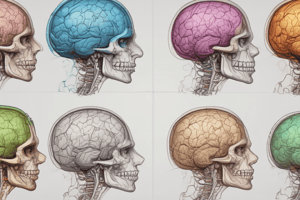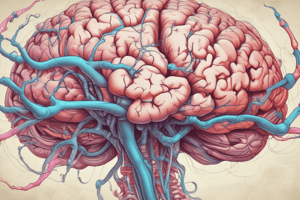Podcast
Questions and Answers
Which structure produces cerebrospinal fluid (CSF) in the third ventricle?
Which structure produces cerebrospinal fluid (CSF) in the third ventricle?
- Pia mater
- Dura mater
- Arachnoid layer
- Choroid plexus (correct)
What is the primary function of the meninges?
What is the primary function of the meninges?
- To form a cushion for the brain and spinal cord (correct)
- To facilitate nerve transmission
- To produce cerebrospinal fluid
- To circulate blood in the brain
Through which structure does the cerebrospinal fluid flow from the third ventricle to the fourth ventricle?
Through which structure does the cerebrospinal fluid flow from the third ventricle to the fourth ventricle?
- Cerebral aqueduct (correct)
- Choroid plexus
- Dural sinus
- Subarachnoid space
What facilitates the exit of CSF from the fourth ventricle?
What facilitates the exit of CSF from the fourth ventricle?
In which space does CSF circulate around the brain and spinal cord?
In which space does CSF circulate around the brain and spinal cord?
How is CSF absorbed into the venous system?
How is CSF absorbed into the venous system?
Which layer of the meninges is known as the 'hard mother'?
Which layer of the meninges is known as the 'hard mother'?
The choroid plexus of which ventricle also produces cerebrospinal fluid?
The choroid plexus of which ventricle also produces cerebrospinal fluid?
Where does CSF ultimately enter after being absorbed into the venous system?
Where does CSF ultimately enter after being absorbed into the venous system?
What is the CSF lactate level indicative of bacterial meningitis?
What is the CSF lactate level indicative of bacterial meningitis?
Which test is considered the gold standard for identifying the causative agent of meningitis?
Which test is considered the gold standard for identifying the causative agent of meningitis?
What role does CSF glutamine primarily serve?
What role does CSF glutamine primarily serve?
What is typically expected in the CSF protein levels of a person with viral meningitis?
What is typically expected in the CSF protein levels of a person with viral meningitis?
Which of the following conditions is associated with elevated CSF glutamine levels?
Which of the following conditions is associated with elevated CSF glutamine levels?
How long can it take to receive results from a CSF culture in tubercular meningitis?
How long can it take to receive results from a CSF culture in tubercular meningitis?
What is the average rate of cerebrospinal fluid (CSF) production in the choroid plexuses per hour?
What is the average rate of cerebrospinal fluid (CSF) production in the choroid plexuses per hour?
What is the total volume of cerebrospinal fluid (CSF) typically found in adults?
What is the total volume of cerebrospinal fluid (CSF) typically found in adults?
What condition is characterized by an abnormal accumulation of CSF in the brain's ventricles?
What condition is characterized by an abnormal accumulation of CSF in the brain's ventricles?
When collecting cerebrospinal fluid (CSF), which lumbar vertebrae are typically used for the procedure?
When collecting cerebrospinal fluid (CSF), which lumbar vertebrae are typically used for the procedure?
What can high intracranial pressure (ICP) lead to if cerebrospinal fluid is collected carelessly?
What can high intracranial pressure (ICP) lead to if cerebrospinal fluid is collected carelessly?
What is a precaution to take during cerebrospinal fluid collection?
What is a precaution to take during cerebrospinal fluid collection?
What volume of cerebrospinal fluid (CSF) is normal for neonates?
What volume of cerebrospinal fluid (CSF) is normal for neonates?
Which condition can elevate intracranial pressure (ICP)?
Which condition can elevate intracranial pressure (ICP)?
What anatomical structures produce cerebrospinal fluid (CSF)?
What anatomical structures produce cerebrospinal fluid (CSF)?
What is a possible consequence of collecting CSF under conditions of high intracranial pressure?
What is a possible consequence of collecting CSF under conditions of high intracranial pressure?
What is the expected lymphocyte to monocyte ratio in normal adult cerebrospinal fluid (CSF)?
What is the expected lymphocyte to monocyte ratio in normal adult cerebrospinal fluid (CSF)?
What type of meningitis is indicated by an increase in neutrophils in the CSF?
What type of meningitis is indicated by an increase in neutrophils in the CSF?
What anatomical landmark corresponds to the L4 vertebra?
What anatomical landmark corresponds to the L4 vertebra?
Which cell types are typically found in the cerebrospinal fluid of patients with viral meningitis in the early stages?
Which cell types are typically found in the cerebrospinal fluid of patients with viral meningitis in the early stages?
What may form in the CSF if it is left to stand?
What may form in the CSF if it is left to stand?
Which intervertebral spaces are the safest for lumbar puncture?
Which intervertebral spaces are the safest for lumbar puncture?
What is the normal glucose level in CSF as a percentage of plasma glucose?
What is the normal glucose level in CSF as a percentage of plasma glucose?
What does crystal clear cerebrospinal fluid (CSF) indicate?
What does crystal clear cerebrospinal fluid (CSF) indicate?
Hazy and turbid cerebrospinal fluid is typically associated with which condition?
Hazy and turbid cerebrospinal fluid is typically associated with which condition?
What should be done before measuring CSF glucose for an accurate result?
What should be done before measuring CSF glucose for an accurate result?
What is the primary clinical significance of finding microorganisms in CSF?
What is the primary clinical significance of finding microorganisms in CSF?
Which type of cell may occasionally be seen in normal adult CSF?
Which type of cell may occasionally be seen in normal adult CSF?
Which lymphocyte to monocyte ratio is expected in children’s CSF?
Which lymphocyte to monocyte ratio is expected in children’s CSF?
Which substance's production within the central nervous system correlates with a hazy CSF appearance?
Which substance's production within the central nervous system correlates with a hazy CSF appearance?
In which condition might there be an increase in lymphocytes and monocytes in the CSF?
In which condition might there be an increase in lymphocytes and monocytes in the CSF?
In a lumbar puncture procedure, how are specimens collected?
In a lumbar puncture procedure, how are specimens collected?
What is the main cause of a typical CSF finding of lymphocytosis?
What is the main cause of a typical CSF finding of lymphocytosis?
What does a milky appearance of CSF typically suggest?
What does a milky appearance of CSF typically suggest?
What is the major significance of white blood cells (WBCs) in cerebrospinal fluid analysis?
What is the major significance of white blood cells (WBCs) in cerebrospinal fluid analysis?
The iliac crests serve as an anatomical reference point for which procedure?
The iliac crests serve as an anatomical reference point for which procedure?
Flashcards are hidden until you start studying
Study Notes
Cerebrospinal Fluid (CSF) Formation and Physiology
- CSF circulates within the ventricles of the brain and the subarachnoid space.
- CSF is produced by the choroid plexuses in the ventricles of the brain.
- CSF production is approximately 20 mL per hour.
- The total volume of CSF in adults is 90-150 mL.
- The total volume of CSF in neonates is 10-60 mL.
CSF Flow
- CSF exits the fourth ventricle through the foramina of Luschka (lateral) and Magendie (medial).
- CSF flows into the subarachnoid space, which surrounds the brain and spinal cord.
- CSF is absorbed into the venous system via arachnoid villi, projecting into the dural sinuses.
Hydrocephalus
- Hydrocephalus is an abnormal accumulation of cerebrospinal fluid in the brain's ventricles.
- It leads to increased intracranial pressure.
CSF Specimen Collection
- CSF is collected via lumbar puncture between the third, fourth, or fifth lumbar vertebra.
- Important Precautions:
- Measurement of Intracranial Pressure:
- High intracranial pressure (ICP) can be present in conditions such as meningitis, intracranial hemorrhage, or tumors.
- Collecting CSF with high ICP can create a pressure differential leading to brain herniation.
- Careful Technique:
- Proper technique is essential to prevent infection or neural tissue damage.
- Measurement of Intracranial Pressure:
Anatomical Landmarks for CSF Collection
- Iliac Crests:
- Palpable landmarks that indicate the approximate level of the L4 vertebra.
- L3-L4 or L4-L5 Intervertebral Space:
- The needle is inserted between L3 and L4 or L4 and L5, as this is the safest and most common site for lumbar puncture.
Clinical Significance of CSF Appearance
- Normal: Crystal Clear
- Abnormal: Hazy, turbid, milky, or cloudy, suggesting disorders affecting the blood-brain barrier.
CSF Cell Count
- Normal: Lymphocytes and monocytes
- Adults: 70L, 30M
- Children: 30L, 70M
- Occasional neutrophils may be seen.
- Abnormal:
- Pleocytosis (increased white blood cell count)
- Neutrophils: Indicative of bacterial meningitis
- Lymphocytes and Monocytes: Indicative of viral, tubercular, fungal, or parasitic meningitis
CSF Glucose
- Normal: 60-70% of plasma glucose
- Abnormal:
- Low CSF glucose levels suggest meningitis.
- Plasma glucose should be measured concurrently for accurate comparison.
CSF Lactate
- Normal: Less than 25 mg/dL
- Abnormal: Elevated lactate levels are seen in bacterial, fungal, and tubercular meningitis.
-
35 mg/dL: Bacterial meningitis
- Less than 25 mg/dL: Viral meningitis
- Decreasing lactate levels indicate successful treatment.
-
CSF Glutamine
- Normal: Serves to remove toxic ammonia from the CNS.
- Abnormal: Elevated glutamine levels are associated with liver disorders resulting in increased ammonia in the blood and CSF.
CSF Protein
- Normal: Low protein content due to the blood-brain barrier.
- Abnormal: Elevated protein levels suggest inflammation or disruption of the blood-brain barrier.
CSF Microbiology
- Culture: Considered the gold standard for identifying the causative agent of meningitis.
- Other tests: Gram staining, Acid-fast staining, India ink, and specific antibody tests.
Studying That Suits You
Use AI to generate personalized quizzes and flashcards to suit your learning preferences.




